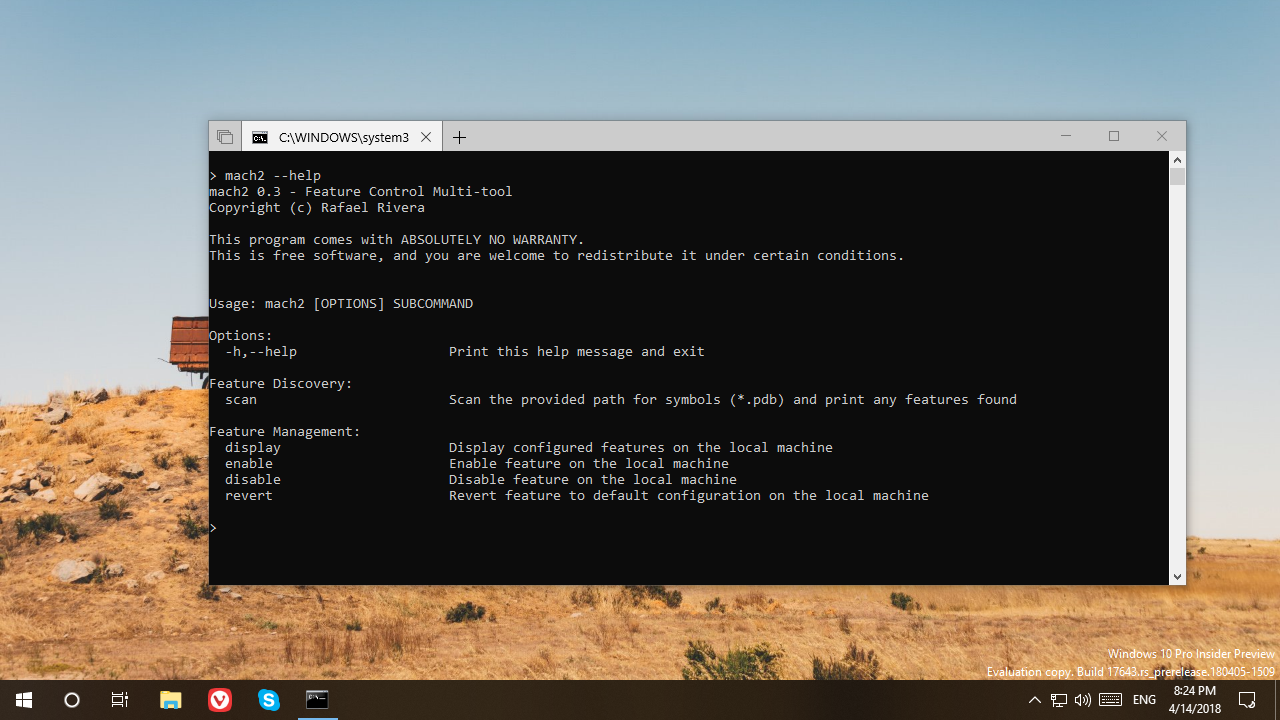Change <mach2 repo directory> into the Directory where you cloned mach2. Example: C:\Users\Test1\source\repos\mach2
Desktop Development with C++
Windows Universal CRT SDK
Windows 10 SDK (10.0.19041.0)
Windows Universal C Runtime
WIndows Driver Kit (10.0.22621.382)
vcpkg Update Baseline: vcpkg.exe x-update-baseline --add-initial-baseline
vcpkg install: vcpkg.exe install --feature-flags=manifests,binarycaching --triplet "x64-windows"
https://pkgs.dev.azure.com/ms/ProjectReunion/_packaging/ProjectReunion-Dependencies/nuget/v3/index.json
(Required because the Microsoft.Taef Dependency with Version 10.58.210222006-develop is otherwise missing)
Press on the "Restore" Button, otherwise use Install-Package Microsoft.Taef -version 10.58.210222006-develop
copy /y "$(ProjectDir)features.txt" "$(OutDir)"
copy /y "$(CurrentVsInstallRoot)\DIA SDK\bin\amd64\msdia140.dll" "$(OutDir)"
copy /y "$(ProjectDir)vcpkg_installed\x64-windows\bin\capstone.dll" "$(OutDir)"
C:\Program Files (x86)\Windows Kits\10\Include\10.0.19041.0\ucrt;<mach2 repo directory>\vcpkg_installed\x64-windows\include
mach2-core.lib;<mach2 repo directory>\vcpkg_installed\x64-windows\lib\capstone.lib;rpcrt4.lib;dbghelp.lib;comsuppw.lib;pathcch.lib;diaguids.lib;ntdll.lib;kernel32.lib;user32.lib;gdi32.lib;winspool.lib;comdlg32.lib;advapi32.lib;shell32.lib;ole32.lib;oleaut32.lib;uuid.lib;odbc32.lib;odbccp32.lib;C:\Program Files (x86)\Windows Kits\10\Lib\10.0.19041.0\ucrt\x64\libucrtd.lib;%(AdditionalDependencies)
C:\Program Files (x86)\Windows Kits\10\Include\10.0.19041.0\ucrt;<mach2 repo directory>\vcpkg_installed\x64-windows\include
C:\Program Files (x86)\Windows Kits\10\Include\10.0.19041.0\ucrt;<mach2 repo directory>\vcpkg_installed\x64-windows\include
mach2-core.lib;<mach2 repo directory>\vcpkg_installed\x64-windows\lib\capstone.lib;rpcrt4.lib;dbghelp.lib;comsuppw.lib;pathcch.lib;diaguids.lib;ntdll.lib;kernel32.lib;user32.lib;gdi32.lib;winspool.lib;comdlg32.lib;advapi32.lib;shell32.lib;ole32.lib;oleaut32.lib;uuid.lib;odbc32.lib;odbccp32.lib;C:\Program Files (x86)\Windows Kits\10\Lib\10.0.19041.0\ucrt\x64\libucrtd.lib;%(AdditionalDependencies)
| Key | Value |
|---|---|
| FILEVERSION | 0, 8, 0, 0 |
| PRODUCTVERSION | 0, 8, 0, 0 |
| FileVersion | 0.8.0.0 |
| ProductVersion | Commit e20cf4d |
Mach2 manages the Windows Feature Store, where Features (and associated on/off state) live. This store lives in the undocumented Windows Notification Facility (WNF), which provides publish-subscribe messaging for kernel components, system services, and user-space applications.
Windows currently contains thousands of Feature switches that turn on and off new and unfinished functionality, mitigations, test hooks, and overrides. Mach2 provides facilities to discover these switches and turn them on or off.
Without going into specifics, Mach2 commands generally fall into one of two buckets:
Mach2 operates on Feature IDs for the bulk of its operations. But finding interesting Features to turn on and off can be a chore, so it includes a scanning function. This function scans Microsoft Program Database (PDB) files for Feature symbols and collects them for review. A user can then review the results and cherry pick which Features warrant further investigation.
Mach2 can dump the current Feature Control store and resolve known IDs to names for convienence. (It reads simple key:value pairs from features.txt on disk.)
With a Feature ID in hand, Mach2 can enable or disable a Feature on the local system. Both of these actions create configuration state for the Feature and set the feature to Enabled or Disabled respectively. The user can also choose to Revert back to the default configuration -- that is, let the Feature turn itself on or off as desired. (There is a Default configuration state that could be set, the tool currently opts to remove reverted features from the configuration store altogether.)
While the tool can manipulate Feature states, the Feature itself drives state compliance. That is, it can choose to ignore its configured state. Various factors, including what's referred to internally as a staging configuration, can dictate whether a Feature respects its configurable state or not. (Always Disabled staged Features, for example, are crippled/stripped during Windows build compilation and cannot be turned on with Feature Control.)
Installation is not required, however Mach2 utilizes registration-free COM activation to bring in DIA SDK components so msdia120.dll must be present.
Compilation requires Visual Studio 2017 or newer, a recent version of the Windows 10 SDK installed, and vcpkg.
vcpkg --feature-flags=manifests installin the mach2 root folder- Open
mach2.slnin Visual Studio - Change the target platform and configuration as needed
- Build
Mach2 relies on CLI11 to provide a canonical command line argument-driven interface. It's recommended you run the tool with --help for details on how to use the tool.
Please never use this tool. The ways in which it can hose your system (and also defeat the purpose of WIP) are myriad.
— Brandon Paddock (@BrandonLive) June 28, 2018 (archived)
You can cite me saying this. Hacking around in internal system state you don’t understand is very risky, and creates an inconsistent state that shouldn’t normally be possible. Plus mucks up data and wastes people’s time.
— Brandon Paddock (@BrandonLive) June 28, 2018 (archived)
Contributions are greatly appreciated. Keep the license in mind (GPLv3).
Try to ping me in advance if you're working on any major changes to ensure we don't clash.
